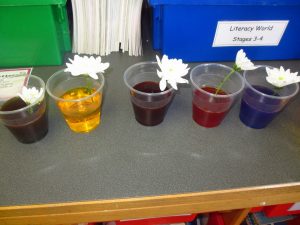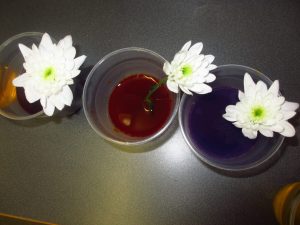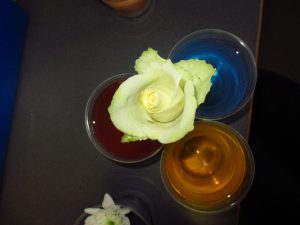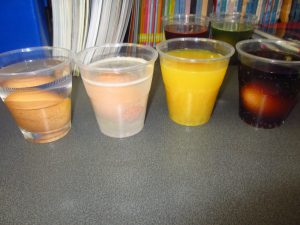Everyone at the Cullivoe Primary School would like to wish Kelly, our clerical assistant, good luck as today is her last day of work before going on maternity leave. We have made her a card and presented her with flowers and the staff gave her a card along with a few goodies. We will miss her but we are very happy to have Norma Graham in to cover Kelly’s maternity cover. We can’t wait to meet baby Keith!
Tag Archives: exciting
P4 -7 Science experiments
On Monday primary 4-7 undertook various experiments about ‘changes’ as this is our topic this term. Here are some of our experiments:
We have placed a white flower into water, with food colouring added in, to see if this changes the colour of the petals. Flowers absorb water through the xylem, which is a tissue of thin tubes found inside the stem. Water is transported to the various parts of the plant including the flower. Because the water is coloured the petals should then take on the colour.


It has been 2 days and the flower in the green water has begun to turn green but there isn’t much change with the other flowers yet. Some of us thought the flower would change within: 5 minutes, 20 minutes, 1 hour or 1 day but we were all wrong with our hypothesis.
We split the stem of a rose into 3 and placed each of these in a different colour, red, blue and yellow, to see if this will give us a rainbow rose.


This hasn’t really changed yet but we know with the other flowers that it could take a while.
We placed eggs into different liquids to see if/how this changes the egg. We have one in water as a control, one is in coke, another in vinegar and the last in fresh orange juice. We discussed our hypothesis on what we thought would happen to each egg:
- The water wouldn’t change the egg
- The coke would dissolve the shell and make it bounce
- The orange juice wouldn’t do anything
- Some thought the vinegar would dissolve the shell and make it bouncy

As soon as we put the egg in the vinegar it started to react by producing lots of bubbles, this is because the calcium carbonate in the shell is dissolved by the acetic acid producing carbon dioxide.
We checked the eggs after 1 day and there were slight changes:
- The water had cracked the egg and it began to seep out
- The coke hadn’t dissolved very little
- The orange juice had dissolved quite a lot which was surprising
- The vinegar had dissolved lots and made the egg squishy and bouncy
We checked the eggs again today and it was very interesting:
- The water hadn’t changed from the day before, it was still split but nothing more has come out
- The coke had dissolved very little but had stained the egg further
- The orange juice dissolved the shell a little more
- The vinegar had made the egg even bigger and bouncier

Below are close ups of the control, orange juice and coke
As you can see the egg in the vinegar is much bigger than the control egg in the water. This is because the membrane around the egg is semi permeable. Whilst it was in the vinegar the liquid moved through the membrane into the egg resulting in the membrane swelling and increasing in size.

We tested how well the vinegar egg could bounce. It bounced from 10cm high so we went up to 20cm and it still bounced so we tried dropping it from 30cm…it didn’t bounce though.
We poured milk into a glass and added red bull. When we discussed what we thought would happen there were a few different thoughts:
- it would curdle
- it would separate
- it would sink to the bottom

You can just about see from the photo there is a layer at the top of the glass. After 5 minutes of pouring in the red bull the acid in the Red Bull causes the protein in the milk to separate. When the milk curdles, a chemical reaction takes place resulting in a precipitate.
We did one more experiment with milk. We placed enough milk on a plate to cover the bottom. Then we poured drops of food colouring into the milk but nothing happened. We then took a cocktail stick and placed one end in fairy liquid before placing this into the milk and food colouring. What happened next was really cool.
The colours began to spread away from the fairy liquid and began mixing together. This is because fat and protein molecules in the milk are altered by the soap. These fat and proteins are super sensitive to change in the milk so when the fairy liquid is added it creates a chemical reaction and causes them to roll around. Once the soap molecules have mixed evenly with the fat and protein molecules the motion stops so we added more fairy liquid to keep the action moving. The food colouring helps us to see this change.
Pancake Day
Yesterday was Pancake day or also named Shrove Tuesday…..
Shrove Tuesday is the day when we eat pancakes. This is the last day before the Christian festival of Lent. In olden days Christians did not eat many foods such as milk, eggs and fats during Lent.
They did not waste food so before Lent began, they had a feast using all the food that would go bad before they could eat it again. Pancakes were a dish that used up the foods by adding some flour.
Lent is the 40 days before Easter – We don’t count Sunday’s though. At this time, our days get longer and it is the start of Spring Time.
Lent begins the day after Pancake Day and the last day ends with Palm Sunday. This is the day when Jesus rode into Jerusalem on a donkey and people waved palm leaves at him and laid them at his feet. Jesus went to the desert for 40 days and nights. He didn’t have any food or water. The devil came and tried to make Jesus eat and drink and made Jesus lots of promises but Jesus said NO!
Lent is a time when Christians give up something special like chocolate. This reminds them when Jesus went into the desert and gave up food.
There are many special days during Lent leading up to Easter. Easter is the most important of all Christian festivals. Lent is a time when Christians prepare for Easter and think of Jesus.
If you were to give up something for Lent what would it be? We had a great discussion of lots of things we could give up.
So yesterday afternoon we made pancakes and our school cook Jem made us pancakes for lunch too so we were very lucky to have pancakes twice!
We got to measure out all the ingredients:
- 200g of flour
- Tablespoon of sugar
- Pinch of salt
- 1 egg
- Milk
Once we measured out all the ingredients we had to mix this together to make the pancake batter. After we got all the lumps out of it we spooned this into the pan to make little individual pancakes to cook them. We all had the chance to flip the pancakes and even tried to flip pancakes from one frying pan to another. It was great fun and there was lots of laughter!
Once the pancakes were cooked we each got to eat one and they were tasty!
Mr Spence
This term we are very lucky to have Brian Spence in with us for a teaching placement. We are very excited to have him in the school and teach us.










